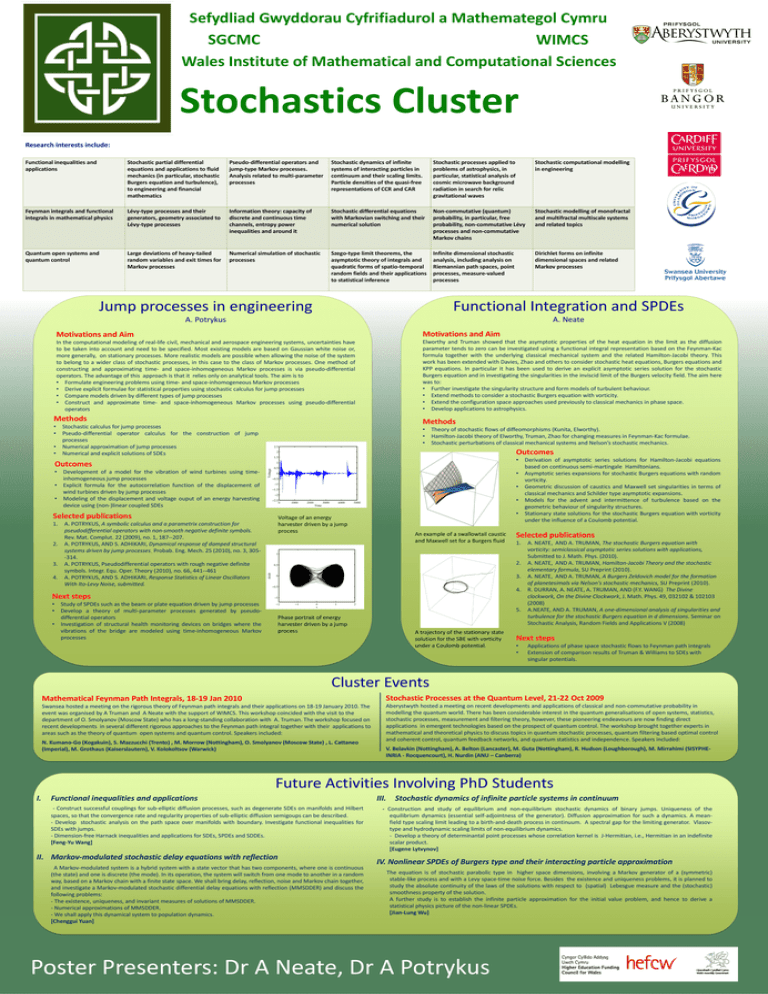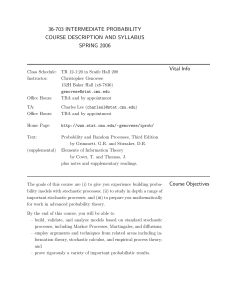UAVs in Agricultural and Environmental Monitoring
advertisement

Sefydliad Gwyddorau Cyfrifiadurol a Mathemategol Cymru SGCMC WIMCS Wales Institute of Mathematical and Computational Sciences Stochastics Cluster Research interests include: Functional inequalities and applications Stochastic partial differential equations and applications to fluid mechanics (in particular, stochastic Burgers equation and turbulence), to engineering and financial mathematics Pseudo-differential operators and jump-type Markov processes. Analysis related to multi-parameter processes Stochastic dynamics of infinite systems of interacting particles in continuum and their scaling limits. Particle densities of the quasi-free representations of CCR and CAR Stochastic processes applied to problems of astrophysics, in particular, statistical analysis of cosmic microwave background radiation in search for relic gravitational waves Stochastic computational modelling in engineering Feynman integrals and functional integrals in mathematical physics Lévy-type processes and their generators, geometry associated to Lévy-type processes Information theory: capacity of discrete and continuous time channels, entropy power inequalities and around it Stochastic differential equations with Markovian switching and their numerical solution Non-commutative (quantum) probability, in particular, free probability, non-commutative Lévy processes and non-commutative Markov chains Stochastic modelling of monofractal and multifractal multiscale systems and related topics Quantum open systems and quantum control Large deviations of heavy-tailed random variables and exit times for Markov processes Numerical simulation of stochastic processes Szego-type limit theorems, the asymptotic theory of integrals and quadratic forms of spatio-temporal random fields and their applications to statistical inference Infinite dimensional stochastic analysis, including analysis on Riemannian path spaces, point processes, measure-valued processes Dirichlet forms on infinite dimensional spaces and related Markov processes Jump processes in engineering Functional Integration and SPDEs A. Potrykus A. Neate Motivations and Aim Motivations and Aim In the computational modeling of real-life civil, mechanical and aerospace engineering systems, uncertainties have to be taken into account and need to be specified. Most existing models are based on Gaussian white noise or, more generally, on stationary processes. More realistic models are possible when allowing the noise of the system to belong to a wider class of stochastic processes, in this case to the class of Markov processes. One method of constructing and approximating time- and space-inhomogeneous Markov processes is via pseudo-differential operators. The advantage of this approach is that it relies only on analytical tools. The aim is to • Formulate engineering problems using time- and space-inhomogeneous Markov processes • Derive explicit formulae for statistical properties using stochastic calculus for jump processes • Compare models driven by different types of jump processes • Construct and approximate time- and space-inhomogeneous Markov processes using pseudo-differential operators Elworthy and Truman showed that the asymptotic properties of the heat equation in the limit as the diffusion parameter tends to zero can be investigated using a functional integral representation based on the Feynman-Kac formula together with the underlying classical mechanical system and the related Hamilton-Jacobi theory. This work has been extended with Davies, Zhao and others to consider stochastic heat equations, Burgers equations and KPP equations. In particular it has been used to derive an explicit asymptotic series solution for the stochastic Burgers equation and in investigating the singularities in the inviscid limit of the Burgers velocity field. The aim here was to: • Further investigate the singularity structure and form models of turbulent behaviour. • Extend methods to consider a stochastic Burgers equation with vorticity. • Extend the configuration space approaches used previously to classical mechanics in phase space. • Develop applications to astrophysics. Methods Methods • Stochastic calculus for jump processes • Pseudo-differential operator calculus for the construction of jump processes • Numerical approximation of jump processes • Numerical and explicit solutions of SDEs • Theory of stochastic flows of diffeomorphisms (Kunita, Elworthy). • Hamilton-Jacobi theory of Elworthy, Truman, Zhao for changing measures in Feynman-Kac formulae. • Stochastic perturbations of classical mechanical systems and Nelson’s stochastic mechanics. Outcomes • Derivation of asymptotic series solutions for Hamilton-Jacobi equations based on continuous semi-martingale Hamiltonians. • Asymptotic series expansions for stochastic Burgers equations with random vorticity. • Geometric discussion of caustics and Maxwell set singularities in terms of classical mechanics and Schilder type asymptotic expansions. • Models for the advent and intermittence of turbulence based on the geometric behaviour of singularity structures. • Stationary state solutions for the stochastic Burgers equation with vorticity under the influence of a Coulomb potential. Outcomes • Development of a model for the vibration of wind turbines using timeinhomogeneous jump processes • Explicit formula for the autocorrelation function of the displacement of wind turbines driven by jump processes • Modeling of the displacement and voltage ouput of an energy harvesting device using (non-)linear coupled SDEs Selected publications 1. 2. 3. 4. Voltage of an energy harvester driven by a jump process A. POTRYKUS, A symbolic calculus and a parametrix construction for pseudodifferential operators with non-smooth negative definite symbols. Rev. Mat. Complut. 22 (2009), no. 1, 187--207. A. POTRYKUS, AND S. ADHIKARI, Dynamical response of damped structural systems driven by jump processes. Probab. Eng. Mech. 25 (2010), no. 3, 305-314. A. POTRYKUS, Pseudodifferential operators with rough negative definite symbols. Integr. Equ. Oper. Theory (2010), no. 66, 441--461. A. POTRYKUS, AND S. ADHIKARI, Response Statistics of Linear Oscillators With Ito-Levy Noise, submitted. An example of a swallowtail caustic and Maxwell set for a Burgers fluid Selected publications 1. 2. 3. 4. Next steps • Study of SPDEs such as the beam or plate equation driven by jump processes • Develop a theory of multi-parameter processes generated by pseudodifferential operators • Investigation of structural health monitoring devices on bridges where the vibrations of the bridge are modeled using time-inhomogeneous Markov processes 5. Phase portrait of energy harvester driven by a jump process A trajectory of the stationary state solution for the SBE with vorticity under a Coulomb potential. A. NEATE, AND A. TRUMAN, The stochastic Burgers equation with vorticity: semiclassical asymptotic series solutions with applications, Submitted to J. Math. Phys. (2010). A. NEATE, AND A. TRUMAN, Hamilton-Jacobi Theory and the stochastic elementary formula, SU Preprint (2010). A. NEATE, AND A. TRUMAN, A Burgers Zeldovich model for the formation of planetesimals via Nelson’s stochastic mechanics, SU Preprint (2010). R. DURRAN, A. NEATE, A. TRUMAN, AND (F.Y. WANG) The Divine clockwork, On the Divine Clockwork, J. Math. Phys. 49, 032102 & 102103 (2008) A.NEATE, AND A. TRUMAN, A one-dimensional analysis of singularities and turbulence for the stochastic Burgers equation in d dimensions. Seminar on Stochastic Analysis, Random Fields and Applications V (2008) Next steps • • Applications of phase space stochastic flows to Feynman path integrals Extension of comparison results of Truman & Williams to SDEs with singular potentials. Cluster Events Mathematical Feynman Path Integrals, 18-19 Jan 2010 Stochastic Processes at the Quantum Level, 21-22 Oct 2009 Swansea hosted a meeting on the rigorous theory of Feynman path integrals and their applications on 18-19 January 2010. The event was organised by A Truman and A Neate with the support of WIMCS. This workshop coincided with the visit to the department of O. Smolyanov (Moscow State) who has a long-standing collaboration with A. Truman. The workshop focused on recent developments in several different rigorous approaches to the Feynman path integral together with their applications to areas such as the theory of quantum open systems and quantum control. Speakers included: Aberystwyth hosted a meeting on recent developments and applications of classical and non-commutative probability in modelling the quantum world. There has been considerable interest in the quantum generalisations of open systems, statistics, stochastic processes, measurement and filtering theory, however, these pioneering endeavours are now finding direct applications in emergent technologies based on the prospect of quantum control. The workshop brought together experts in mathematical and theoretical physics to discuss topics in quantum stochastic processes, quantum filtering based optimal control and coherent control, quantum feedback networks, and quantum statistics and independence. Speakers included: N. Kumano-Go (Kogakuin), S. Mazzucchi (Trento) , M. Morrow (Nottingham), O. Smolyanov (Moscow State) , L. Cattaneo (Imperial), M. Grothaus (Kaiserslautern), V. Kolokoltsov (Warwick) V. Belavkin (Nottingham), A. Belton (Lancaster), M. Guta (Nottingham), R. Hudson (Loughborough), M. Mirrahimi (SISYPHEINRIA - Rocquencourt), H. Nurdin (ANU – Canberra) Future Activities Involving PhD Students I. Functional inequalities and applications - Construct successful couplings for sub-elliptic diffusion processes, such as degenerate SDEs on manifolds and Hilbert spaces, so that the convergence rate and regularity properties of sub-elliptic diffusion semigoups can be described. - Develop stochastic analysis on the path space over manifolds with boundary. Investigate functional inequalities for SDEs with jumps. - Dimension-free Harnack inequalities and applications for SDEs, SPDEs and SDDEs. [Feng-Yu Wang] II. Markov-modulated stochastic delay equations with reflection A Markov-modulated system is a hybrid system with a state vector that has two components, where one is continuous (the state) and one is discrete (the mode). In its operation, the system will switch from one mode to another in a random way, based on a Markov chain with a finite state space. We shall bring delay, reflection, noise and Markov chain together, and investigate a Markov-modulated stochastic differential delay equations with reflection (MMSDDER) and discuss the following problems: - The existence, uniqueness, and invariant measures of solutions of MMSDDER. - Numerical approximations of MMSDDER. - We shall apply this dynamical system to population dynamics. [Chenggui Yuan] III. Stochastic dynamics of infinite particle systems in continuum - Construction and study of equilibrium and non-equilibrium stochastic dynamics of binary jumps. Uniqueness of the equilibrium dynamics (essential self-adjointness of the generator). Diffusion approximation for such a dynamics. A meanfield type scaling limit leading to a birth-and-death process in continuum. A spectral gap for the limiting generator. Vlasovtype and hydrodynamic scaling limits of non-equilibrium dynamics. - Develop a theory of determinantal point processes whose correlation kernel is J-Hermitian, i.e., Hermitian in an indefinite scalar product. [Eugene Lytvynov] IV. Nonlinear SPDEs of Burgers type and their interacting particle approximation The equation is of stochastic parabolic type in higher space dimensions, involving a Markov generator of a (symmetric) stable-like process and with a Levy space-time noise force. Besides the existence and uniqueness problems, it is planned to study the absolute continuity of the laws of the solutions with respect to (spatial) Lebesgue measure and the (stochastic) smoothness property of the solution. A further study is to establish the infinite particle approximation for the initial value problem, and hence to derive a statistical physics picture of the non-linear SPDEs. [Jian-Lung Wu] Poster Presenters: Dr A Neate, Dr A Potrykus






